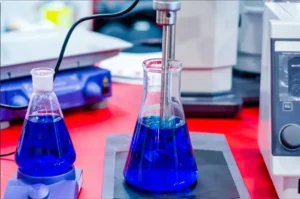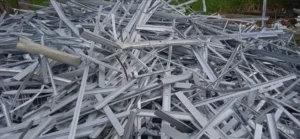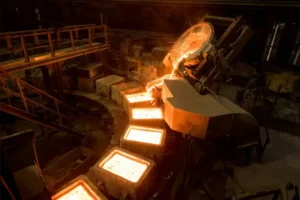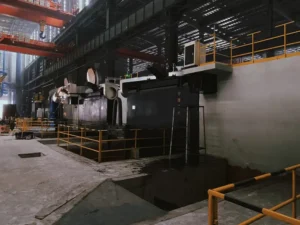In the modern foundry industry, induction furnaces are widely used due to their high efficiency, পরিচ্ছন্নতা, and ease of control. যাহোক, during the melting process, invisible gases—primarily hydrogen (H), নাইট্রোজেন (N), এবং অক্সিজেন (ও)—act as “invisible killers,” silently infiltrating the molten metal and creating significant hidden dangers for the final quality of the casting. The most typical defect caused by these gases is porosity. A deep understanding of the sources and hazards of these gases, combined with mastery of advanced control strategies, is crucial for improving casting quality and reducing the scrap rate.
Sources of Gases: Three Major Channels Not to Be Ignored
Gases are introduced into the molten metal primarily through the following three channels, which are interconnected and collectively affect the purity of the melt.
1.Moist Charge Materials and Tools
This is the most direct and significant source of gas, especially hydrogen, in the melting process.
- Source Mechanism: Whether it’s recycled scrap, alloying agents, or various additives, if they become damp, are exposed to rain, or are contaminated with oil, emulsions, or other water-containing substances during storage or transport, the moisture (H₂O) will rapidly decompose at high temperatures. উদাহরণ স্বরূপ, molten iron reacts with water vapor at high temperatures:
- Fe+H2O→FeO+2[H]
- The resulting atomic hydrogen [H] is extremely active and has a high diffusion capacity, allowing it to dissolve quickly into the molten metal. একইভাবে, rust (hydrates) on the surface of the charge material will release crystal water at high temperatures, becoming a significant source of hydrogen.
- Influencing Factors: The storage environment of the charge materials, weather conditions (rainy seasons, high humidity), and the adequacy of preheating all directly determine the amount of moisture introduced into the furnace. Melting tools (such as slag rakes and thermocouple protection tubes) that have not been sufficiently preheated or baked will cause the moisture on their surfaces to decompose instantly upon contact with the high-temperature melt, leading to severe localized hydrogen absorption.
2.Air Humidity and Ambient Atmosphere
The water vapor, নাইট্রোজেন, and oxygen naturally present in the air are a continuous source of gas for the molten metal.
- উত্স Mechanism:
- Hydrogen: During melting and pouring, the surface of the molten metal exposed to the air continuously reacts with atmospheric water vapor, causing hydrogen to dissolve into the melt. The higher the ambient humidity, the faster the reaction rate, and the more severe the melt’s tendency to absorb hydrogen.
- Nitrogen and Oxygen: In an induction furnace, the surface of the molten bath is in direct contact with the atmosphere. Nitrogen (N₂) এবং অক্সিজেন (O₂) from the air enter the melt through physical dissolution or chemical reactions. The solubility of nitrogen and oxygen in metal increases significantly at higher melting temperatures. এই ক্ষেত্রে, in molten steel, nitrogen and oxygen dissolve in their atomic states, [N] এবং [ও].
3.Refractory Materials
The furnace lining is a critical component of an induction furnace, but under certain conditions, it can also become an indirect source of gas.
- উত্স Mechanism:
- New Linings: Newly installed or patched linings, whether acidic, নিরপেক্ষ, বা বেসিক, contain a certain amount of moisture (both physical water and chemically bound water). If the lining is not thoroughly and properly baked, this moisture will be gradually released during heating and come into contact with the molten metal, leading to an increase in hydrogen content.
- Old Linings: Used furnace linings can absorb moisture from the air. আরও, some oxides in the refractory materials (such as SiO₂) may react with certain elements in the melt (like C) under specific conditions, producing gases such as CO. While this does not directly introduce H or N, it increases the total gas content of the melt and can trigger other types of porosity defects.
The Harm of Gases: The Culprit of Gas Porosity in Castings
The solubility of gases dissolved in molten metal decreases sharply as the temperature drops. During the solidification process, as the metal transitions from a liquid to a solid state, these supersaturated gases precipitate out to form bubbles. If these bubbles fail to escape in time, they become trapped within or on the surface of the casting, forming Gas Porosity.
- Hydrogen Porosity: This is the most common type of gas porosity. Because the solubility of hydrogen in solid metal is far lower than in liquid metal, a large amount of hydrogen precipitates during solidification, with atoms combining to form high-pressure micro-bubbles. These pores are typically round or oval and are distributed within the casting, especially in the last areas to solidify (such as hot spots).
- Nitrogen Porosity: Nitrogen porosity is particularly prominent when melting stainless steel, high-alloy steels, and other alloys containing elements that form stable nitrides with nitrogen. Nitrogen pores usually appear just below the casting’s skin, are small in size, and can be pin-shaped or worm-like in a dense distribution.
- Complex Porosity: In many cases, porosity is caused by the combined action of multiple gases. উদাহরণ স্বরূপ, CO gas generated from the reaction of carbon and oxygen in the melt, along with precipitated hydrogen and nitrogen, can form bubbles together, making the porosity problem more complex.
Gas porosity defects severely reduce the effective load-bearing cross-sectional area of a casting, degrading its mechanical properties (such as strength, plasticity, and toughness) and its density. For pressure-tight castings like valves and pump bodies, porosity is a critical and unacceptable defect.
Advanced Gas Control Strategies: A Comprehensive Defense from Source to Finish
To produce high-quality, porosity-free castings, a systematic gas control strategy must be adopted, covering all stages from pre-melting and in-process melting to post-tapping.
1.Source Control: Strict Management of Charge Materials
- Drying Charge Materials: All charge materials, especially light, thin, and moisture-prone materials like turnings and chips, must undergo rigorous preheating and baking before being charged into the furnace to ensure the complete removal of moisture and oil. Establishing dedicated charge material drying equipment is recommended.
- পরিবেশগত নিয়ন্ত্রণ: The charge material storage area should be kept dry and well-ventilated, protected from rain and humid conditions. During high-humidity seasons, inspection and preheating of materials should be intensified.
- Lining Bake-out: Strictly adhere to the baking curve and holding times provided by the refractory supplier to ensure that new or repaired linings are fully sintered and all moisture is expelled.
2.Advanced In-Process Control Technologies
Vacuum Refining
ভ্যাকুয়াম ইন্ডাকশন গলে (ভিম) is one of the most effective technologies for controlling gas content. Its principle is based on creating a vacuum environment where the partial pressure of gases is extremely low, thereby drastically reducing their solubility in the molten metal.
- কাজের নীতি: By melting under a vacuum, dissolved gases like hydrogen and nitrogen rapidly escape from the melt due to the significant pressure differential. The vacuum also effectively removes harmful tramp elements with low melting points and high vapor pressures, such as lead and zinc. আরও, it promotes the carbon-oxygen reaction ([গ] + [ও] → {কো}↑), allowing the resulting CO gas to be pumped out, achieving deep purification of the melt.
- সুবিধা: It can produce ultra-clean molten metal with extremely low gas content (যেমন, H ≤ 2 পিপিএম, N ≤ 20 পিপিএম, O ≤ 10 পিপিএম), making it an essential technology for producing high-performance castings for the aerospace, precision alloy, and other high-end industries.
Argon Purging (Sparging)
This is a highly efficient and economical method for in-furnace degassing and refining.
- কাজের নীতি: An inert gas—argon—is introduced into the molten metal as fine bubbles through a porous plug installed at the bottom or sidewall of the furnace, or via an immersion lance. According to Dalton’s Law of Partial Pressures, the rising argon bubbles provide a nucleus with a very low partial pressure for dissolved gases like hydrogen and nitrogen. This encourages these dissolved gases to diffuse into the argon bubbles and escape with them from the melt.
- সুবিধা: It not only effectively removes hydrogen and nitrogen but also stirs the molten bath, which helps to homogenize the melt’s composition and temperature and promotes the flotation and removal of inclusions. The process is simple to operate, requires minimal modification to existing induction furnaces, and is relatively low-cost.
Flux or Desiccant Covering
Using specific covering agents to create a physical barrier on the surface of the molten metal during melting is an effective way to prevent the melt from reacting with the atmosphere.
- কাজের নীতি:
- Physical Isolation: The covering agent, or flux, melts to form a stable slag layer that effectively insulates the melt from the air, preventing secondary gas absorption (hydrogen, নাইট্রোজেন) and oxidation.
- Chemical Refining: Some refining fluxes contain components that react with gases or oxides in the melt. উদাহরণ স্বরূপ, certain degassing agents produce fine bubbles at high temperatures, creating a “washing” effect similar to gas purging. Some deoxidizing agents effectively remove oxygen from the melt, reducing oxide inclusions.
- শোষণ: Certain basic or neutral fluxes can also adsorb non-metallic inclusions, helping to purify the melt.
- Application: The appropriate covering flux must be selected based on the type of alloy being melted. উদাহরণ স্বরূপ, in aluminum melting, chlorine-based or chlorine-free environmentally friendly refining fluxes are commonly used for degassing and impurity removal.
উপসংহার
Gas control in induction furnace melting is a systematic engineering process. It begins with strict control over sources like moist charge materials, air humidity, and refractory linings; continues with meticulous operational practices during melting; and culminates in deep purification using advanced technologies such as vacuum refining, argon purging, and high-performance covering fluxes. Only by deeply understanding the potential harm that gases pose to casting quality and by applying a comprehensive set of control strategies can foundries consistently produce high-quality castings that meet stringent requirements and remain competitive in a challenging market.







